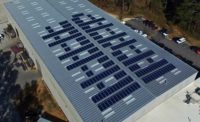WASHINGTON—The U.S. Department of Energy (DOE) is partnering with the U.S. Department of the Treasury and the Internal Revenue Service (IRS) to provide $10 billion in funding through the Qualifying Advanced Energy Project Credit (48C). The notice released June 5 allocates up to $4 billion to accelerate domestic clean energy manufacturing and ensure no community is left behind in the transition to clean energy technologies.
The Qualifying Advanced Energy Project Credit (48C)—established by the 2009 Recovery Act and expanded with a $10 billion investment under the Inflation Reduction Act—aims to strengthen U.S. industrial competitiveness and clean energy supply chains. As the nation builds a net-zero economy, the 48C tax credit aims to help create high-quality jobs, reduce industrial emissions, and increase domestic production of critical clean energy products and materials. In particular, the 48C program provides a carve-out for projects in communities with closed coal plants and mines, where the existing infrastructure and workforce are well-suited to the demands of new clean energy manufacturing.
In 2009, the first round of 48C credits allocated $2.3 billion to nearly 200 clean energy manufacturing projects across 43 states. Funding ranged from renewable energy technology projects, such as solar components and materials, to lithium-ion batteries for clean transportation and turbines for nuclear and hydropower facilities. The investments were estimated to directly generate 17,000 jobs and stimulate an additional 41,000 jobs through private investment.
The 2009 round of 48C was oversubscribed three-to-one, indicating a strong pipeline of clean energy manufacturing projects in the United States. Since then, momentum in the energy transition has grown stronger. Given the other demand- and supply-side investments under the Inflation Reduction Act and Bipartisan Infrastructure Law, the DOE expects a diverse set of 48C applicants in the new round announced this month.
New guidance describes the submission requirements to request a credit allocation from the approximately $4 billion in the initial first round of the expanded program, $1.6 billion of which will be set aside for projects in designated energy communities with closed coal plants or mines. In addition, the DOE is aiming to leverage credit allocations in the first round to support a diverse portfolio of investments, including in the small- and medium-sized manufacturers that form the backbone of local and regional economies and supply chains. After a robust merit review process, the program will provide an investment tax credit of up to 30 percent of qualified investments in certified projects that meet prevailing wage and apprenticeship requirements.
The newly released guidance provides information on the DOE application process and DOE’s 48C eXCHANGE web portal. DOE will review applications against core eligibility and technical criteria. Similar to previous rounds of 48C, the program will consider criteria like commercial viability, timely project timelines, and greenhouse gas emissions impacts. This latest round of review will also address modern challenges including supply chain growth and resilience as well as workforce and community engagement.
The DOE opened the 48C eXCHANGE portal for applicants to download application materials on May 31. For this round of the program, the DOE will begin accepting concept papers no later than June 30, and all concept papers must be submitted by July 31. For more information, clickhere.


